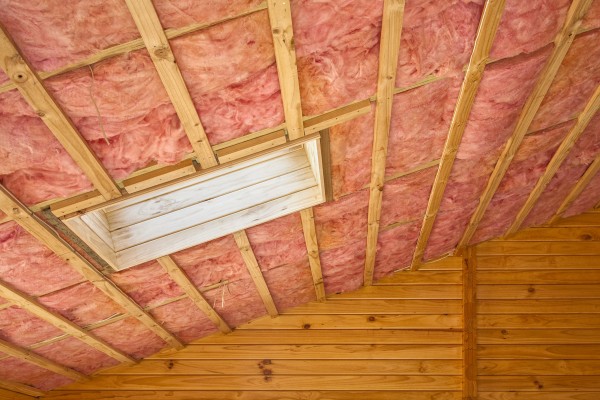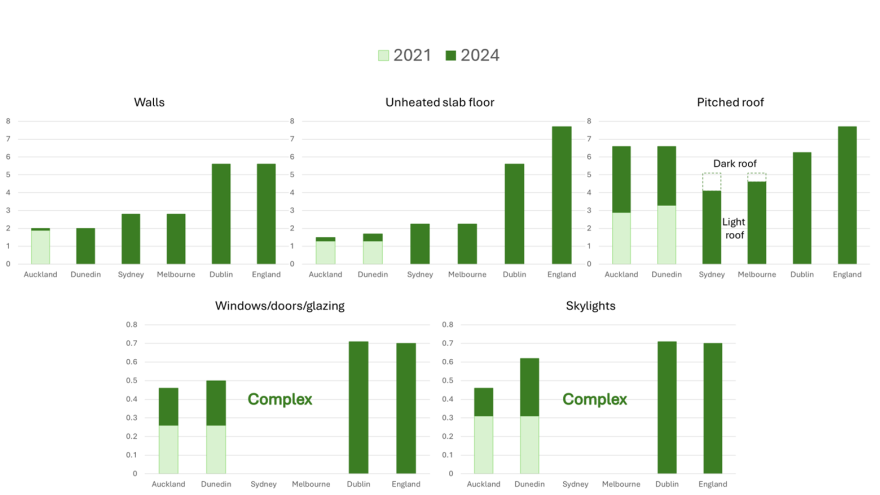References
- Ministry of Business Innovation & Employment. Outcome of consultation: Building code update 2021. New Zealand: New Zealand Government, 2021.
- Jaques R, Sullivan J, Dowdwell D, et al. Thermal, financial and carbon review of NZBC energy efficiency clause H1/AS1 thermal envelope requirements for residential and small buildings. Judgeford, New Zealand: Building Research Assocation of New Zealand Ltd, 2020.
- Ministry of Business Innovation & Employment. Outcome of consultation Building Code update 2022: Transition period for the energy efficiency of housing. New Zealand: New Zealand Government, 2022.
- Hindley D. NZ vs Australia building regs. Build 2020(180):84 - 85.
- Hindley D. NZ vs Ireland building regs. Build 2020(181):68 - 70.
- Hindley D. Rating our building regs - Part 1. Build 2020(179):50 - 51.
- Howden-Chapman P, Viggers H, Chapman R, et al. Tackling cold housing and fuel poverty in New Zealand: A review of policies, research, and health impacts. Energy Policy 2012;49:134-42. doi: 10.1016/j.enpol.2011.09.044
- Telfar-Barnard L, Bennett J, Robinson A, et al. Evidence base for a housing warrant of fitness. SAGE open medicine 2019;7:2050312119843028. doi: 10.1177/2050312119843028 [published Online First: 2019/04/20]
- Telfar-Barnard L, Bennett J, Howden-Chapman P, et al. Measuring the effect of housing quality interventions: the case of the New Zealand "Rental Warrant of Fitness". Int J Environ Res Public Health 2017;14(11)
- Telfar Barnard L, Howden-Chapman P, Pierse N. Renting Poorer Housing: Ecological Relationships Between Tenure, Dwelling Condition, and Income and Housing-Sensitive Hospitalizations in a Developed Country. Health Educ Behav 2020;47(6):816-24. doi: 10.1177/1090198120945923
- Grimes A, Preval N, Young C, et al. Does retrofitted insulation reduce household energy use? Theory and Practice. The Energy Journal 2016;37(4) doi: http://dx.doi.org/10.5547/01956574.37.4.agri
- Grimes A, Denne T, Howden-Chapman P, et al. Cost benefit analysis of the Warm Up New Zealand: Heat Smart Programme. New Zealand: Motu, 2012.
- World Health Organisation. WHO Housing and health guidelines. Geneva: World Health Organisation, 2018.
- Free S, Howden-Chapman P, Pierse N, et al. More effective home heating reduces school absences for children with asthma. J Epidemiol Community Health 2010;64(5):379-86. doi: 10.1136/jech.2008.086520 [published Online First: 2009/09/25]
- Howden-Chapman P, Matheson A, Crane J, et al. Effect of insulating existing houses on health inequality: cluster randomised study in the community. British Medical Journal 2007;334:460.
- Fyfe C, Telfar L, Barnard, et al. Association between home insulation and hospital admission rates: retrospective cohort study using linked data from a national intervention programme. BMJ 2020;371:m4571. doi: 10.1136/bmj.m4571 [published Online First: 2020/12/31]
- Fyfe C, Barnard LT, Douwes J, et al. Retrofitting home insulation reduces incidence and severity of chronic respiratory disease. Indoor Air 2022;32(8):e13101. doi: 10.1111/ina.13101
- Preval N, Keall M, Telfar-Barnard L, et al. Impact of improved insulation and heating on mortality risk of older cohort members with prior cardiovascular or respiratory hospitalisations. BMJ open 2017;7(11):e018079. doi: 10.1136/bmjopen-2017-018079 [published Online First: 2017/11/16]
- Telfar Barnard L, Preval N, Howden-Chapman P, et al. The impact of retrofitted insulation and new heaters on health services utilisation and costs, pharmaceutical costs and mortality: Evaluation of Warm Up New Zealand: Heat Smart. Report to the Ministry of Economic Development. Wellington, 2012.
- O'Sullivan K, Telfar Barnard L, Viggers H, et al. Child and youth fuel poverty: assessing the known and unknown. People, place and policy 2016;10(1):77-87.
- Amundsen AH, Klæboe R, Aasvang GM. Long-term effects of noise reduction measures on noise annoyance and sleep disturbance: the Norwegian facade insulation study. J Acoust Soc Am 2013;133(6):3921-8. doi: 10.1121/1.4802824
- Howden-Chapman P, Saville-Smith K, Crane J, et al. Risk factors for mold in housing: a national survey. Indoor Air 2005;15(6):469-76. doi: 10.1111/j.1600-0668.2005.00389.x
- Douwes J, Pearce N. Invited Commentary: Is Indoor Mold Exposure a Risk Factor for Asthma? American Journal of Epidemiology 2003;158(3):203-06. doi: 10.1093/aje/kwg149
- Shorter C, Crane J, Pierse N, et al. Indoor visible mold and mold odor are associated with new-onset childhood wheeze in a dose-dependent manner. Indoor Air 2018;28(1):6-15. doi: 10.1111/ina.12413 [published Online First: 20170911]
- Tin Tin S, Woodward A, Saraf R, et al. Internal living environment and respiratory disease in children: findings from the Growing Up in New Zealand longitudinal child cohort study. Environmental health : a global access science source 2016;15(1):120. doi: 10.1186/s12940-016-0207-z [published Online First: 20161208]
- Viggers H, Keall M, Wickens K, et al. Increased house size can cancel out the effect of improved insulation on overall heating energy requirements. Energy Policy 2017;107:248-57. doi: https://doi.org/10.1016/j.enpol.2017.04.045
- Page IC, Jung J. Housing life cycle and sustainability: Part One. Study Report. New Zealand: BRANZ, 2009.
- Shorter C, Crane J, Barnes P, et al. The cost of achieving healthy temperatures in children's bedrooms: Evidence from New Zealand. Energy Policy 2022;164:112861. doi: https://doi.org/10.1016/j.enpol.2022.112861
About the Briefing
Public health expert commentary and analysis on the challenges facing Aotearoa New Zealand and evidence-based solutions.
Subscribe

Public Health Expert Briefing
Get the latest insights from the public health research community delivered straight to your inbox for free. Subscribe to stay up to date with the latest research, analysis and commentary from the Public Health Expert Briefing.

